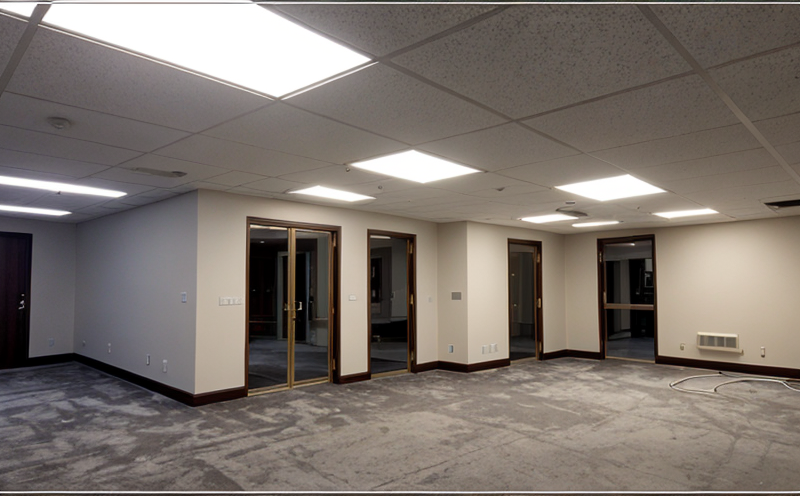IEC 61547 EMC Immunity Testing of Decorative Lighting Equipment
The IEC 61547 standard is internationally recognized for its stringent requirements in ensuring that decorative lighting equipment can withstand electromagnetic interference (EMI) and electromagnetic compatibility (EMC) challenges. This testing ensures that the lighting equipment functions effectively in a complex electromagnetic environment, safeguarding both the integrity of the product and compliance with international standards.
The EMC immunity tests are essential to assess how well the equipment can function under conditions where it is subjected to various types of electromagnetic interference. These tests include exposure to conducted and radiated emissions, electrostatic discharge (ESD), voltage dips, and transients. The purpose is to verify that the lighting equipment maintains its specified performance levels without malfunction or degradation.
During these tests, the specimen is placed in a controlled environment where it is subjected to specific test signals designed to simulate real-world conditions. The testing apparatus includes specialized equipment such as an EMC immunity test chamber, power supply simulators, and measurement instruments like spectrum analyzers and field strength meters. Compliance with IEC 61547 ensures that the lighting equipment meets stringent requirements for safety, performance, and reliability.
The testing process involves several steps to ensure thorough evaluation of the specimen's resilience against EMI. The first step is the preparation of the specimen according to the standard’s specifications. This includes ensuring the equipment is in its operational state and that all components are properly connected. The second step is the setup of the test environment, including calibration of the testing apparatus. Once set up, the specimen is subjected to a series of predefined test conditions.
The tests are conducted under various environmental conditions to simulate real-world use scenarios. This includes testing for EMI in both indoor and outdoor environments, as well as exposure to different types of interference sources such as radiofrequency fields, conducted emissions, and transient voltage surges. The results are meticulously recorded and analyzed to ensure compliance with the IEC 61547 standard.
Compliance with this standard is crucial for manufacturers aiming to enter international markets where stringent regulatory requirements are enforced. It ensures that the lighting equipment performs reliably under adverse electromagnetic conditions, enhancing product safety and customer satisfaction.
| Applied Standards | Description |
|---|---|
| IEC 61547-2: EMC Immunity Tests for Decorative Lighting Equipment | The standard defines the specific tests and criteria used to evaluate the immunity of decorative lighting equipment against various types of electromagnetic interference. |
| IEC 61547-3: Conducted Emissions Limits for Decorative Lighting Equipment | This part specifies the limits on conducted emissions that ensure the equipment does not interfere with other electronic devices in its vicinity. |
| Use Cases and Application Examples | Description |
|---|---|
| Testing for EMI Immunity in Decorative Lighting | The testing ensures that the lighting equipment can function effectively even when subjected to a variety of electromagnetic interference sources. |
| Evaluating Conducted and Radiated Emissions Compliance | This aspect checks whether the emitted signals from the lighting equipment meet specified limits, ensuring it does not interfere with other devices. |
- Testing is conducted in controlled environments to ensure accurate results.
- Data analysis involves detailed measurement and recording of performance metrics.
- The final report includes comprehensive data on the specimen’s performance under various test conditions.
Applied Standards
The IEC 61547 standard is a crucial benchmark for ensuring that decorative lighting equipment meets stringent safety and performance requirements. This section outlines the specific standards applied during EMC immunity testing.
| Applied Standards | Description |
|---|---|
| IEC 61547-2: EMC Immunity Tests for Decorative Lighting Equipment | This part of the standard defines the specific tests and criteria used to evaluate the immunity of decorative lighting equipment against various types of electromagnetic interference. |
| IEC 61547-3: Conducted Emissions Limits for Decorative Lighting Equipment | This section specifies the limits on conducted emissions that ensure the equipment does not interfere with other electronic devices in its vicinity. |
International Acceptance and Recognition
The IEC 61547 standard is widely recognized and accepted across the globe, making it a key requirement for manufacturers aiming to comply with international regulations. Compliance ensures that decorative lighting equipment can be marketed globally without facing regulatory barriers.
Many countries have adopted this standard as part of their national standards, ensuring consistency in testing protocols and results. This acceptance is crucial for manufacturers who need to ensure their products meet the stringent requirements set by various markets around the world.
Use Cases and Application Examples
- Testing for EMI Immunity in Decorative Lighting
- Evaluating Conducted and Radiated Emissions Compliance
- Ensuring Safety in Outdoor Lighting Applications
- Verifying Performance in Urban Scenarios
- Compliance for Indoor Commercial Lighting Installations
| Use Cases and Application Examples | Description |
|---|---|
| Testing for EMI Immunity in Decorative Lighting | The testing ensures that the lighting equipment can function effectively even when subjected to a variety of electromagnetic interference sources. |
| Evaluating Conducted and Radiated Emissions Compliance | This aspect checks whether the emitted signals from the lighting equipment meet specified limits, ensuring it does not interfere with other devices. |





